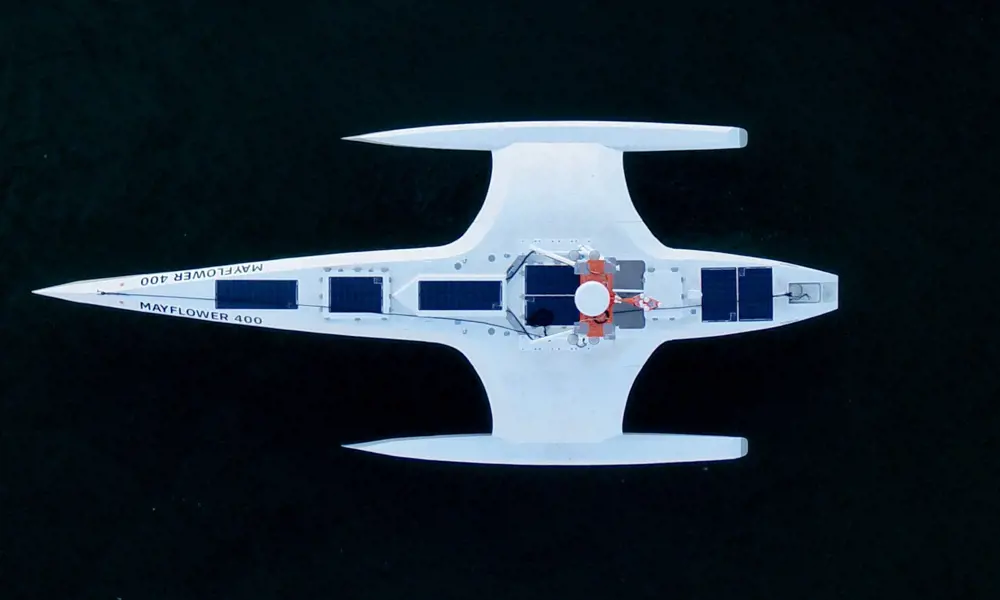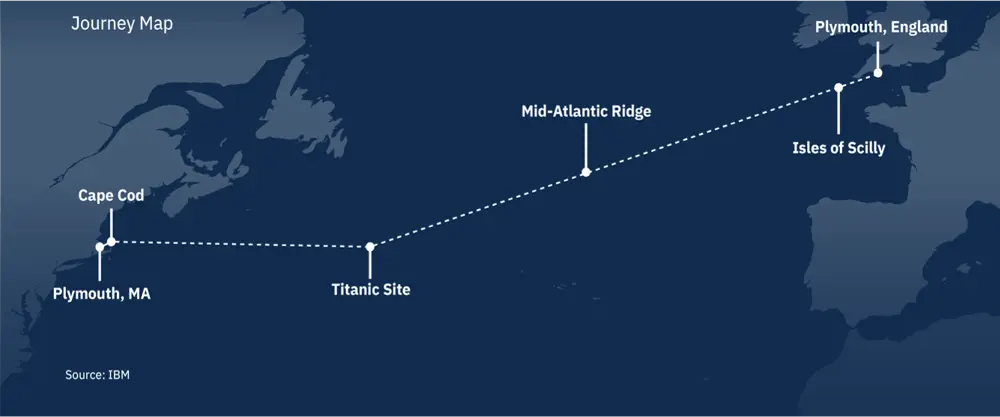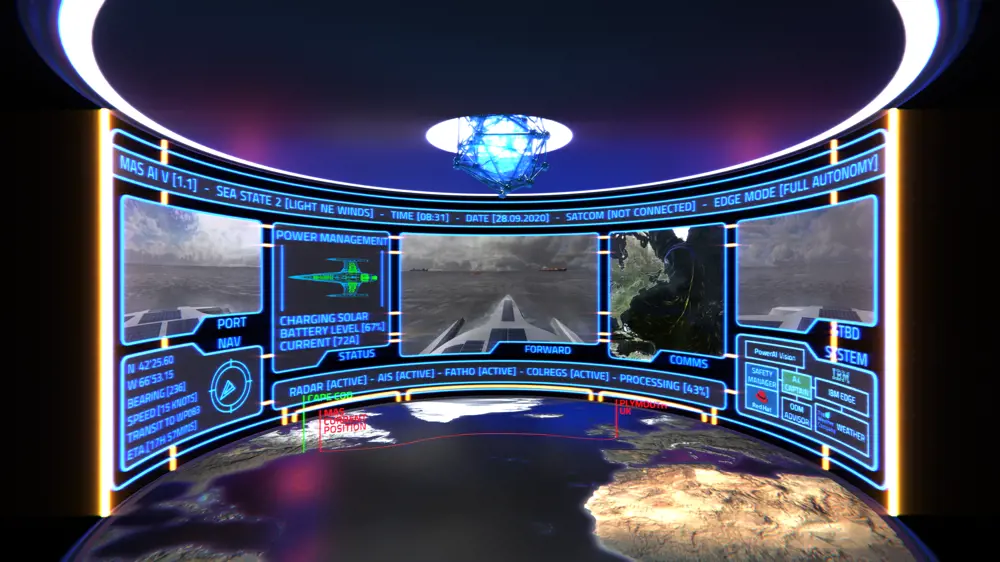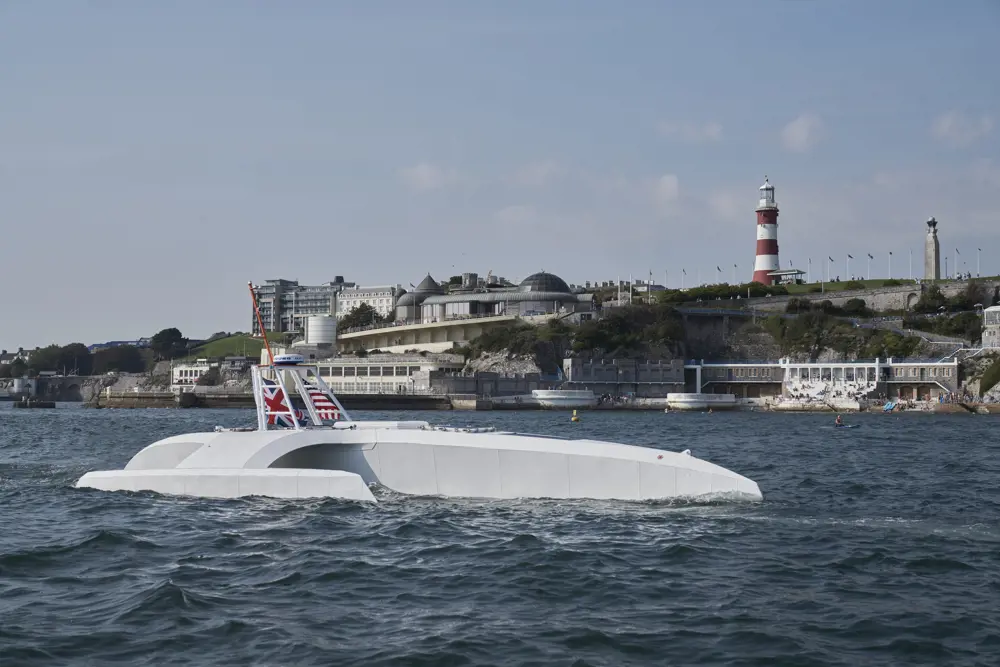
The Mayflower sails again
In 1620, the Mayflower ship embarked on a voyage to discover the New World of America. In the US, the arrival and endurance of the ship’s English settlers are remembered every Thanksgiving and part of the country’s history, while in the UK it is rarely acknowledged.
For 10 gruelling weeks, the square-rigged Mayflower ship ploughed across one of the world’s most inhospitable oceans, battling howling westerly winds and massive swell waves. This is a perilous journey even by today’s standards, and the name of the 1620 ship has been given to a new mission: to create a fully autonomous ship capable of traversing oceans independently, gathering data about critical issues such as plastic pollution, global warming and marine mammal conservation.
The autonomous ship was originally scheduled to set sail in September 2020 from Plymouth Harbour in the UK to Plymouth, Massachusetts, on the 400th anniversary of the original Mayflower’s departure. However, this latest voyage has been delayed because of the coronavirus pandemic and will now take place in spring 2021. But what does it take to construct a 15-metre-long ship capable of travelling over 3,100 miles without any crew, charting its own two-week course across an ocean?

The route of the 3,100-mile journey that the autonomous vessel will take © IBM
Designing the project
The Mayflower Autonomous Ship (MAS) project was conceived by Brett Phaneuf, the Co-Founder of American non-profit marine research organisation ProMare. The design and construction contract was awarded to Plymouth-based uncrewed underwater vehicle manufacturer MSubs, whose spinout company Marine AI was tasked with building the core software for the artificial intelligence (AI) captain. Following a chance encounter between MAS’s designer and an IBM engineer at a conference in Switzerland, IBM executives were introduced to ProMare as the latter sought a technology partner. Having watched IBM’s Watson AI technology win the Jeopardy! game show in the US, ProMare knew it needed a ‘Captain Watson’ for its ship; IBM’s array of edge computing and AI-training servers enabled ProMare to appoint a single lead IT partner.
Professor Andy Stanford-Clark is IBM’s Chief Technology Officer for the UK and Ireland, and he’s been involved with the MAS project for the last 18 months. He points out that although MSubs has extensive experience of automated systems, these are very different from autonomous ones: “Automated systems follow pre-programmed actions, and they wouldn’t really know what to do if they got into uncharted waters. By contrast, an autonomous system has learned how to react in a completely unforeseen situation and will hopefully follow the right course of action.”
it’s a floating science experiment, which will be conducting detailed oceanic analysis of everything from microplastics levels to whale song throughout its journey
The distinction between automated and autonomous is significant, since there have already been uncrewed Atlantic crossings of remote-control vessels piloted from a command centre. An autonomous vessel less than two metres long also travelled from Canada to Ireland in 2018. However, the MAS is more than simply an empty vessel – it’s a floating science experiment, which will be conducting detailed oceanic analysis of everything from microplastics levels to whale song throughout its journey.
Preparing the ship to navigate across the ocean
Ensuring an uncrewed but fully loaded research vessel can navigate its way across one of the world’s largest oceans represents an enormous undertaking. Simply being able to identify objects around it requires huge amounts of raw data, as Andy explains: “We’ve uploaded two and a half million images from yachts to icebergs, all labelled. ProMare has had cameras installed at its R&D stations in the Plymouth Sound for two years, giving us a ship’s eye view with lots of photos of similar things in very different weather and sea conditions.” This image library has been fed into IBM’s visual recognition software as a building block of the ship’s AI captain. The AI captain can view its surroundings and make decisions about how to react according to rules-based logic: “You might have an iceberg on one side and an oil tanker on the other side, a container floating in the water and a storm coming, and the AI has to decide what to do.”
You might have an iceberg on one side and an oil tanker on the other side, a container floating in the water and a storm coming, and the AI has to decide what to do
The team also carried out extensive tests to characterise how the vessel turns. Andy explains: “If you turn the rudder a certain number of degrees, how many metres does it takes to start turning, what’s the turning circle of the ship and its capability for accelerating and decelerating? That way, when we put the AI captain on board we can programme these parameters, and it will have some prior understanding of how the ship will behave.”

Visualisation of the Mayflower’s digital twin data showing data sources and the AI captain’s decision-making © IBM
To predict likely scenarios MAS might encounter during its journey, Marine AI constructed a digital twin and conducted thousands of hours of simulated sailing. “There’s an awful lot we can do with a digital twin simulator,” says Andy. “These environments have been putting the AI captain through its paces for months, and it’s been a key part of the training system. We can put anything we want into the virtual cameras – we can add in a ship and an iceberg, a buoy and a seagull, and see what it would do next.” This machine learning simulation has helped to prepare the vessel for a crossing that is likely to be significantly impacted by changes in the weather and ocean. These challenges (and others) will be monitored by real-time sensory inputs including radar with a 2.5 nautical mile range, GPS navigation and a vehicle management system reminiscent of the ones found in electric cars.
Numerous nautical rules have been fed into the ship’s automated decision system, but a simpler philosophy underpinned MAS’s instructions when encountering obstacles and climatic challenges. “At sea you have longer to react, and you can track the speed and direction of potential obstacles,” says Andy. “As a last resort, MAS can just stop in the water, assess the situation and take its time to decide what to do next. In almost all situations, a crash is avoidable.” Providing MAS remains facing into the waves, it’s very unlikely to capsize.
To predict likely scenarios MAS might encounter during its journey, Marine AI constructed a digital twin and conducted thousands of hours of simulated sailing
Efficient design to collect scientific data
To minimise any risk of capsizing, MAS has been honed to ensure optimal performance and maximum stability. A trimaran is an inherently stable design, while the absence of human personnel on board allows incredible space-efficiency. Andy points out: “You don’t need a galley, food storage or toilets. An uncrewed vessel sets different design parameters, and sitting lower in the water becomes much easier because you don’t need headroom. The vessel’s heaviest contents are the batteries that will support night-time travel, and the onboard biodiesel generator to help out if the solar panels aren’t able to generate sufficient power.”
While the original Mayflower sailed with enough space to store 180 tonnes of cargo for its 140 crew and passengers, MAS is packed with scientific equipment intended to examine oceanic wellbeing, pollution and marine life. The central hull contains a dozen different research pods whose experiments were suggested and devised by academics and oceanographers. Andy explains how a robotic water sampling system will record the density of microplastics across the ocean: “It’s going to collect bottled water samples throughout the journey by opening a little tap inside the boat, filling up a bottle, putting a cap on, and placing it in the fridge before waiting for a few hours to do the next one.” This fully automated process will be conducted at sea and analysed later in a laboratory along with reams of recorded data on tidal patterns, the depth of the ocean and even the nuances of whalesong as detected by an underwater hydrophone.

A cross-section of the Mayflower shows its different components and systems. In a ship designed to have no crew on board, all available space can be dedicated to the systems and scientific apparatus for experiments © IBM
Another automated process will be the distribution of automatic identification system (AIS) messages between MAS and vessels in its vicinity. AIS allows ships and boats to safely pass each other, but MAS’s instructions will be customised to inform other craft that it has no crew. This complements visual signage and a lighting regime designed to highlight its lack of crew. To further minimise the chances of a collision, the AI system has been programmed with numerous nautical regulation guides like the Safety of Life at Sea (SOLAS) treaty, and the Convention on the International Regulations for Preventing Collisions at Sea (COLREGs).
Marine cybersafety
While maritime traffic poses one potential hazard, another threat lies in potential attempts by hackers to commandeer the vessel and use it for either piracy or weaponisation. “Marine cybersecurity is a really big area,” Andy says, “because people tend to assume once a ship sets sail it’s safe and self-contained, but that isn’t the case. Ships have a local area network (LAN) and Wi-Fi, and any number of computer systems, IP addresses and satellite communications, which all make them a hacking target.” As a result, MAS uses edge computing technology to secure its hardware, permitting secure connections through firewalls: “You have to design it like a company intranet, with all the security and firewalls and VPNs you’d normally need to secure an enterprise system.”
The onboard edge devices are essential because there may be lengthy periods where MAS is unable to communicate with the teams on land. Indeed, IBM is assuming it has no communications potential at any point in the crossing. “Any data we do receive back is a bonus,” says Andy. “It will be constantly trying to provide operational data from both the ship and the science experiments. We’ll be learning from the feedback from the AI systems about how it’s doing and how confident the AI vision system is about what the cameras are seeing, with tonnes of data being collected and some of it offboarded during the journey.” If data can’t be transmitted en route across the satellite link, it will be stored on an SD card and offloaded after the vessel’s safe return.
You have to design it like a company intranet, with all the security and firewalls and VPNs you’d normally need to secure an enterprise system

The technology might be used to operate ferries, such as the floating bridges crossing Norwegian fjords. Personal water taxis could make efficient use of under-utilised urban waterways and simultaneously alleviate congestion on land. Meanwhile, autonomous vessels could transform the exploration of our oceans, increasing our knowledge and understanding of remote bodies of water by conducting real-time analysis under AI stewardship © Tom Barnes for IBM and ProMare
Bright futures for autonomous vessels
Although MAS’s forthcoming journey represents an epic challenge, the ProMare and IBM team is already looking at how this pioneering technology could be advanced further. “Future versions of the AI software will have the ability for experiments to investigate interesting situations that arise. A boat might deviate from its existing mission and go somewhere else, after weighing up the conflicting requirements of the opportunity that’s presented itself, the mission objectives and its remaining power. There might even be fleets of autonomous vessels going out and collecting research data. There are really interesting ‘hive mind’ experiments with swarms of autonomous ships working together to achieve an overall objective.”
MAS could also spearhead the introduction of AI serving as a second pair of eyes to a human captain: “From talking to insurers, you can imagine a future where they actually require that kind of system to be on board before they’ll insure a ship. There are really interesting developments in augmented intelligence rather than AI, which will have quite a profound impact on the industry.” Andy describes a nautical version of the autopilot systems on an aeroplane, leaving the complex take-off and landing to humans but automating everything in between. Historic maritime rules mean only manned craft can currently sail into or out of harbours; the only exception is for vessels with ‘eyes on’ – someone in attendance watching. MAS will be escorted into harbour by a manned vessel with a short-range radio-control link. However, autonomous port operations are being tested at the Port of Rotterdam, which may ultimately enable autonomous vessels to complete the final leg of their journeys without needing human oversight.
As well as crossing the Atlantic independently, MAS’s greatest legacy may be the cutting-edge technology. “It’s a wonderful showcase of a whole range of technologies, all working together to solve really gnarly problems,” Andy concludes. “It’s a chance to demonstrate different pieces of software working together – the cloud and AI vision systems, the Internet of Things and edge computing. We see a great future in AI captain software for the autonomous operation of vessels of many sizes, from container ships down to personal water taxis. We’ve already had a lot of conversations with people in the military and research sectors who are interested in using this technology in the future, wanting to know how it works and how they can get hold of it. It’s getting really busy really quickly.”
***
Since the making of this article, the Mayflower successfully set off from Plymouth, UK in June 2021, arriving in Plymouth, Massachusetts in June 2022.
This article has been adapted from "The Mayflower sails again", which originally appeared in the print edition of Ingenia 86 (March 2021).
Contributors
Professor Andy Stanford-Clark is the Chief Technology Officer for IBM in UK and Ireland. He is an IBM Distinguished Engineer, a Master Inventor with more than 40 patents, and IBM’s Quantum Leader for the UK. Andy is a Visiting Professor at Newcastle University, an Honorary Professor at the University of East Anglia, an Adjunct Professor at the University of Southampton, and a Fellow of the British Computer Society.
Keep up-to-date with Ingenia for free
SubscribeRelated content
Software & computer science

Compact atomic clocks
Over the last five decades, the passage of time has been defined by room-sized atomic clocks that are now stable to one second in 100 million years. Experts from the Time and Frequency Group and the past president of the Institute of Physics describe a new generation of miniature atomic clocks that promise the next revolution in timekeeping.

The rise and rise of GPUs
The technology used to bring 3D video games to the personal computer and to the mobile phone is to take on more computing duties. How have UK companies such as ARM and ImaginationTechnologies contributed to the movement?

EU clarifies the European parameters of data protection
The European Union’s General Data Protection Regulation, due for adoption this year, is intended to harmonise data protection laws across the EU. What are the engineering implications and legal ramifications of the new regulatory regime?

Evolving the internet
He may have given the world the technology that speeded up the internet, but in his next move, Professor Nick McKeown FREng plans to replace those networks he helped create.
Other content from Ingenia
Quick read

- Environment & sustainability
- Opinion
A young engineer’s perspective on the good, the bad and the ugly of COP27

- Environment & sustainability
- Issue 95
How do we pay for net zero technologies?
Quick read

- Transport
- Mechanical
- How I got here
Electrifying trains and STEMAZING outreach

- Civil & structural
- Environment & sustainability
- Issue 95